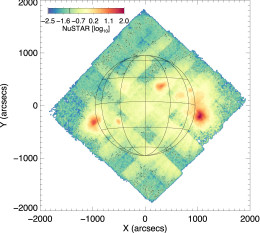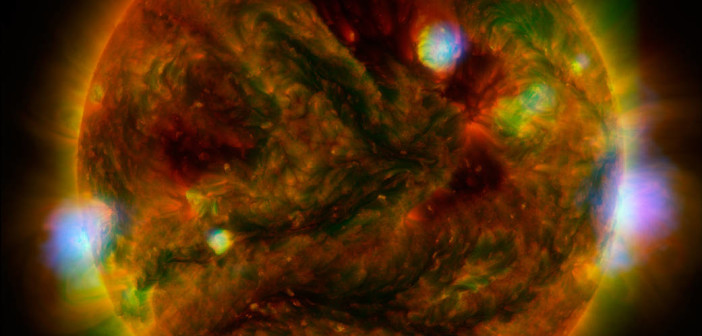The Nuclear Spectroscopic Telescope Array (NuSTAR) is a space telescope primarily designed to detect high-energy X-rays from faint, distant astrophysical sources. Recently, however, it’s occasionally been pointing much closer to home, with the goal of solving a few longstanding mysteries about the Sun.

Intensity maps from an observation of a quiet-Sun region near the north solar pole and an active region just below the solar limb. The quiet-Sun data will be searched for small flares that could be heating the solar corona, and the high-altitude emission above the limb may provide clues about particle acceleration. [Adapted from Grefenstette et al. 2016]
An Unexpected Target
Though we have a small fleet of space telescopes designed to observe the Sun, there’s an important gap: until recently, there was no focusing telescope making solar observations in the hard X-ray band (above ~3 keV). Conveniently, there is a tool capable of doing this: NuSTAR.
Though NuSTAR’s primary mission is to observe faint astrophysical X-ray sources, a team of scientists has recently conducted a series of observations in which NuSTAR was temporarily repurposed and turned to focus on the Sun instead.
These observations pose an interesting challenge precisely because of NuSTAR’s extreme sensitivity: pointing at such a nearby, bright source can quickly swamp the detectors. But though the instrument can’t be used to observe the bright flares and outbursts from the Sun, it’s the perfect tool for examining the parts of the Sun we’ve been unable to explore in hard X-rays before now — such as faint flares, or the quiet, inactive solar surface.
In a recently published study led by Brian Grefenstette (California Institute of Technology), the team describes the purpose and initial results of NuSTAR’s first observations of the Sun.
Solar Mysteries
What is NuSTAR hoping to accomplish with its solar observations? There are two main questions that hard X-ray observations may help to answer.
- How are particles accelerated in solar flares?
The process of electron acceleration during solar flares is not well understood. When a flare-producing active region is occulted by the solar limb, NuSTAR will able to directly observe the flare loop above the solar surface — which is where that acceleration is thought to happen. - How is the solar corona heated?
The solar corona is a toasty 1–3 million Kelvin — significantly warmer than the ~6000 K solar photosphere. So how is the corona heated? One proposed explanation is that the Sun’s surface constantly emits tiny nanoflares — in active regions, or even in the quiet Sun — that are so faint that we haven’t detected them. But with its high sensitivity, NuSTAR may be able to!

The first NuSTAR full-disk mosaic of the Sun. The checkerboard pattern is an artifact of the detectors being hit by particles from active regions outside of the field of view — a problem which will be reduced as the Sun enters the upcoming quieter part of the solar cycle. [Adapted from Grefenstette et al. 2016]
First Observations
In NuSTAR’s first four observations of the Sun, the team unexpectedly observed a major flare (which unsurprisingly swamped the detectors), watched the emission above an active region that was hidden by the solar limb, stared at a section of quiet Sun near the north solar pole, and composed a full-disk mosaic of the solar surface from 16 12’ x 12’ tiles.
All of these initial observations are currently being carefully analyzed and will be presented in detail in future publications. In the meantime, NuSTAR has demonstrated its effectiveness in detecting faint emission in solar hard X-rays, proving that it will be a powerful tool for heliophysics as well as for astrophysics. We look forward to seeing the future results from this campaign!
Citation
Brian W. Grefenstette et al 2016 ApJ 826 20. doi:10.3847/0004-637X/826/1/20

1 Comment
Pingback: NuSTAR checks out the Sun